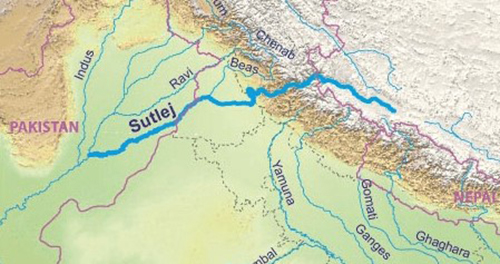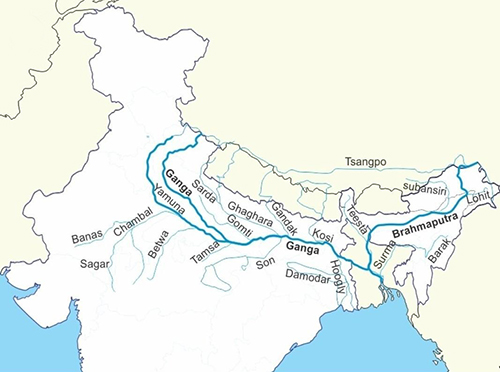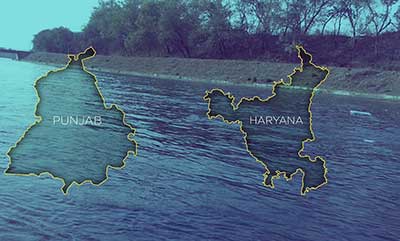Date: 12/10/2022
Relevance: GS-2: Functions and Responsibilities of the Union and the States, Issues and Challenges Pertaining to the Federal Structure
Key Phrases: Riparian Principle, Eradi Tribunal, PM Krishi Sinchai Yojana - Per drop more crop, Drip Irrigation, Inter State Water Disputes
Why in News?
- The Supreme Court in its directive has recently called for an amicable solution to the Sutlej Yamuna Link (SYL) canal issue. Thus, the decades-old dispute between the two neighbouring states is back in the limelight.
Background:
- The issue dates back to 1966, from the time of the reorganisation of Punjab.
- When Haryana was formed, Punjab was opposed to sharing the waters of Ravi and Beas with the newly formed state citing the riparian principle.
- The riparian principle says that the state through which a river passes has the right to its waters.
Share of stakeholder states over the waters of Ravi and Beas:
- A decade before the formation of Haryana, the water flowing down Ravi and Beas was assessed at 15.85 million acre-feet (MAF).
- The Union government in 1955 allotted 8 MAF to Rajasthan while the undivided Punjab’s share was 7.20 MAF and J&K got 0.65 MAF.
- A decade after reorganisation, the Centre issued a notification allocating 3.5 MAF to Haryana out of Punjab’s 7.2 MAF.
- In a reassessment in 1981, the water flowing down Beas and Ravi was pegged at 17.17 MAF, out of which 4.22 MAF was allocated to Punjab, 3.5 MAF to Haryana, and 8.6 MAF to Rajasthan.
Do you know?
Inter-state water dispute: Constitutional provisions
- Water is a state subject as per entry 17 of state list which includes water supplies, irrigation and canals, drainage and embankments, water storage and water power subject to the provisions of Entry 56 of List - I.
- Article 262 of the Constitution deals with adjudication of water
disputes. The provisions in this regard are:
- Article 262 (1): "Parliament may, by law, provide for the adjudication of any dispute or complaint with respect to the use, distribution or control of the waters of, or in, any inter-State river or river valley."
- Article 262 (2):"Notwithstanding anything in this Constitution, Parliament may, by law, provide that neither the Supreme Court nor any other court shall exercise jurisdiction in respect of any such dispute or complaint as is referred to in clause (1)."
The SYL canal project(SYLC):
- It is a proposed 214-kilometre-long canal connecting the Sutlej and Yamuna river out of which 122 km was to cross Punjab and 92 km in Haryana.
- It was planned in 1966 post the reorganisation of the state of Punjab into Haryana and Punjab.
- Punjab had rejected this proposal on the basis of Riparian Principle and the lack of groundwater availability with it which negates any possibility of sharing water.
- Haryana is also suffering from water crisis and needs water resources of the proposed link canal to fulfil its drinking water requirement
- Haryana has already built its share of project with almost no action from Punjab side on SYLC.

Eradi Tribunal:
- The Eradi Tribunal headed by Supreme Court Judge V Balakrishna Eradi was set up to reassess availability and sharing of water.
- The Tribunal, in 1987, recommended an increase in the shares of Punjab and Haryana to 5 MAF and 3.83 MAF, respectively.
SYL and violence in Punjab:
- In 1985, Longowal was killed by militants, less than a month after signing the accord.
- In 1990, a chief engineer M L Sekhri and a Superintending Engineer were killed by militants besides killing of labourers.
- This led to the construction coming to a halt.
- In the backdrop of these incidents, Punjab leaders have been cautioning the Centre not to raise up the issue again, which could be misutilized by Pakistan and other secessionist groups
State of water crisis in Punjab :
- As per a government study, many areas in Punjab may go dry after 2029.
- The state has already over-exploited its groundwater for irrigation by growing wheat and paddy worth Rs 70,000 crore every year.
- As per the report, water in about 79 per cent area of the state is over-exploited.
- Out of 138 blocks, 109 blocks are “over-exploited”, two blocks are “critical” while five blocks are “semi-critical” and only 22 blocks are in “safe” category.
- In the situation of such an acute water shortage the government is reluctant to share it with any other state.
Haryana’s reasons:
- Haryana has been staking claim on Ravi-Beas waters through the SYL canal on the plea that providing water for irrigation is a tough task for the state.
- In southern parts, where the underground water has depleted up to 1700 feet, there is a shortage of drinking water.
- The state’s contribution to the central food pool will be jeopardised due to inability to provide water through irrigation.
Sutlej river:
- The Sutlej is the longest of the five rivers that flow through the historic crossroads region of Punjab in northern India and Pakistan and it is the easternmost tributary of the Indus River.
- There are various hydroelectric power and irrigation projects over the river like the Kol Dam, Bhakra Nangal Dam, Baspa Hydroelectric Power Project, and Nathpa Jhakri Project.

- The source of the Sutlej is west of the catchment area of Lake Rakshastal in Tibet, as springs in an ephemeral stream.
- Ropar Wetland in Punjab state is located on the Sutlej river basin.
- The Sutlej meets the Beas River in Hari-Ke-Patan in Amritsar in Punjab, India and flows to the southwest, penetrating Pakistan to join the Chenab River, creating the Panjnad River (Five Rivers Of Punjab).
- The Five Rivers of Punjab meet the Indus River at Mithankot.
- The waters of the Satluj River are distributed to India according to the Indus Waters Treaty between Pakistan and India and are primarily shifted to the irrigation channels in India.
Yamuna river:
- The Yamuna is the second-largest tributary river of the Ganges by discharge and the longest tributary in India.
- Originating from the Yamunotri Glacier at a height of about 4,500 m on the southwestern slopes of Bandarpunch peaks of the Lower Himalaya in Uttarakhand.
- It merges with the Ganges at Triveni Sangam, Allahabad, which is a site of the Kumbh Mela, a Hindu festival held every 12 years.
- It passes through the states of Haryana, Uttar Pradesh, Uttarakhand, Delhi and Himachal Pradesh.

- Its tributaries are Tons, Chambal, (its longest tributary which has its own large basin), followed by Sindh, the Betwa, and Ken.
- It helps create the highly fertile alluvial Ganges-Yamuna Doab region between itself and the Ganges in the Indo-Gangetic plain.
Conclusion:
- Punjab is preparing to stick to its stand and seek a fresh tribunal.
- Punjab is already going towards desertification and thus, cannot afford to give away any water.
- The government needs to refrain from politicising the issue and aim for a solution which is beneficial to both states.
Source: Indian Express
Mains Question:
Q. Discuss the causes of inter-state water disputes in India as well as the constitutional and legal provisions related to it. (150 words).






















